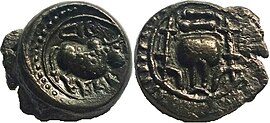
Back Dinastia Vishnukundina Catalan વિષ્ણુકુંડિન વંશ Gujarati 비슈누쿤디나 왕조 Korean Višnukundinų dinastija Lithuanian விஷ்ணுகுந்தினப் பேரரசு Tamil విష్ణుకుండినులు Tegulu Династія Вішнукундіна Ukrainian
This article includes a list of general references, but it lacks sufficient corresponding inline citations. (March 2016) |
Vishnukundina dynasty | |||||||||||
|---|---|---|---|---|---|---|---|---|---|---|---|
| 420–624 | |||||||||||
Vishnukundina Empire, 420–674 AD, cast copper, 4.65g, Vidarbha (Maharashtra), Bull type. | |||||||||||
The Vishnukundinas and neighbouring South Asian polities c. 500 CE.[1] | |||||||||||
| Capital | Indrapalanagara Denduluru Amaravati | ||||||||||
| Common languages | Sanskrit Prakrit Telugu | ||||||||||
| Religion | Hinduism Jainism | ||||||||||
| Government | Monarchy | ||||||||||
| Janasraya | |||||||||||
| Historical era | Classical India | ||||||||||
• Established | 420 | ||||||||||
• Disestablished | 624 | ||||||||||
| |||||||||||
The Vishnukundina dynasty (IAST: Viṣṇukundina) was an Indian dynasty based in Deccan, which ruled territory comprising present-day Andhra Pradesh, Telangana, Odisha and other parts of southern India during the 5th and 7th centuries, carving land out from the Vakataka Empire. It played an important role in the history of the Deccan during the 5th and 7th centuries. The dynasty initially ruled from Indrapalanagara (in present day Nalgonda district of Telangana), and later shifted to Denduluru, and Amaravathi.[2]
The area north of the Godavari, Kalinga became independent, the area south of the Krishna River fell to the Pallavas. The Vishnukundina reign came to an end with the conquest of the eastern Deccan by the Chalukya, Pulakeshin II. Pulakeshi appointed his brother Kubja Vishnuvardhana as viceroy to rule over the conquered lands. Eventually, Vishnuvardhana declared his independence and started the Eastern Chalukya dynasty.
- ^ Schwartzberg, Joseph E. (1978). A Historical atlas of South Asia. Chicago: University of Chicago Press. p. 26,146. ISBN 0226742210.
- ^ Sarma, A. Rajeswara (2009). "Indrapura: The capital city of Vishnukundi dynasty". Proceedings of the Indian History Congress. 70: 138–141. ISSN 2249-1937. JSTOR 44147663.
© MMXXIII Rich X Search. We shall prevail. All rights reserved. Rich X Search


